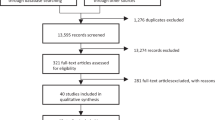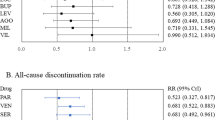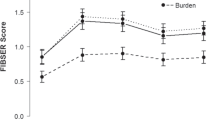Abstract
Developing antidepressants that are not only more effective but are rapidly acting is the Holy Grail for psychiatry. We review multiple issues that arise in determining rapid responses in antidepressant trials. The current status of purportedly rapid acting agents is first reviewed. Then, a number of key questions/issues are addressed: Is there a unifying definition for rapid response across studies? Should rapid response criteria be based on required measurable effects on overall improvement? On specific symptoms such as psychomotor retardation, depressed mood, or anhedonia? In associated symptoms such as anxiety or insomnia? When should onset be considered rapid—by Day 3? Day7? Day 14? If there is a rapid response, for how long should the effects be maintained? Is maintenance of effect dependent on continuing the medication? Is rapid response associated with specific mechanisms of action? Do the mechanisms of action suggest possible risk for drug abuse? How important is rapid response really in an often chronic or recurrent depressive disorder? In which types of patients could rapid response be particularly important? What are the study design issues that need to be considered for assessing rapid response, including: selection of specific types of depressed patients, multiple doses of drug studied, designation of primary and secondary outcome measures, specific time points at which to determine efficacy, requirements for demonstrating durability, etc. A framework for approaching this complex area is developed for both researchers and clinicians.
This is a preview of subscription content, access via your institution
Access options
Subscribe to this journal
Receive 13 print issues and online access
$259.00 per year
only $19.92 per issue
Buy this article
- Purchase on Springer Link
- Instant access to full article PDF
Prices may be subject to local taxes which are calculated during checkout
Similar content being viewed by others
References
Koran LM, Pallanti S, Paiva RS, Quercioli L. Pulse loading versus gradual dosing of intravenous clomipramine in obsessive-compulsive disorder. Eur Neuropsychopharmacol. 1998;8:121–6.
Kasper S, Müller-Spahn F. Intravenous antidepressant treatment: focus on citalopram. Eur Arch Psychiatry Clin Neurosci. 2002;252:105–9.
Mühlbacher M, Konstantinidis A, Kasper S, Eichberger G, Hinterhuber H, Hofmann P, et al. Intravenous mirtazapine is safe and effective in the treatment of depressed inpatients. Neuropsychobiology. 2006;53:83–87.
Pollock BG, Perel JM, Nathan RS, Kupfer DJ. Acute antidepressant effect following pulse loading with intravenous and oral clomipramine. Arch Gen Psychiatry. 1989;46:29–35.
Schatzberg AF. Anna-Monika Award Lecture, DGPPN Kongress, 2013: the role of the hypothalamic-pituitary-adrenal (HPA) axis in the pathogenesis of psychotic major depression. World J Biol Psychiatry. 2015;16:2–11.
Block T, Petrides G, Kushner H, Kalin N, Belanoff J, Schatzberg A. Mifepristone plasma level and glucocorticoid receptor antagonism associated with response in patients with psychotic depression. J Clin Psychopharmacol. 2017;37:505–11.
Block TS, Kushner H, Kalin N, Nelson C, Belanoff J, Schatzberg. A combined analysis of mifepristone for psychotic depression: plasma levels associated with clinical response. Biol Psychiatry. 2018;84:46–54.
Zarate CA Jr, Singh JB, Carlson PJ, Brutsche NE, Ameli R, Luckenbaugh DA, et al. A randomized trial of an N-methyl-D-aspartate antagonist in treatment-resistant major depression. Arch Gen Psychiatry. 2006;63:856–64.
Popova V, Daly EJ, Trivedi M, Cooper K, Lane R, Lim P, et al. Efficacy and safety of flexibly dosed esketamine nasal spray combined with a newly initiated oral antidepressant in treatment-resistant depression: a randomized double-blind active-controlled study. Am J Psychiatry. 2019;176:428–38.
Daly EJ, Trivedi MH, Janik A, Li H, Zhang Y, Li X, et al. Efficacy of esketamine nasal spray plus oral antidepressant treatment for relapse prevention in patients with treatment-resistant depression: a randomized clinical trial. JAMA Psychiatry. 2019;76:893–903.
Fu DJ, Ionescu DF, Li X, Lane R, Lim P, Sanacora G, et al. Esketamine nasal spray for rapid reduction of major depressive disorder symptoms in patients who have active suicidal ideation with intent: double-blind, randomized study (ASPIRE I). J Clin Psychiatry. 2022;81:19m13191.
Meltzer-Brody S, Colquhoun H, Riesenberg R, Epperson CN, Deligiannidis KM, Rubinow DR, et al. Brexanolone injection in post-partum depression: two multicentre, double-blind, randomised, placebo-controlled, phase 3 trials. Lancet. 2018;392:1058–70.
Gunduz-Bruce H, Silber C, Kaul I, Rothschild AJ, Riesenberg R, Sankoh AJ, et al. Trial of SAGE-217 in patients with major depressive disorder. N Engl J Med. 2019;381:903–11.
Clayton AH, Lasser R, Parikh SV, Iosifescu DV, JungAh J, Kotecha M, et al. Zuranolone for the treatment of adults with major depressive disorder: a randomized, placebo-controlled phase 3 trial. Am J Psychiatry. 2023;3:appiajp20220459/.
Clayton AH, Lasser R, Nandy I, Sankoh AJ, Jonas J, et al. Zuranolone in major depressive disorder: results from MOUNTAIN—A Phase 3, multicenter, double-blind, randomized, placebo-controlled trial. J Clin Psychiatry. 2023;84:22m14445.
Iosifescu DV, Jones A, O'Gorman C, Streicher C, Feliz S, Fava M, et al. Efficacy and safety of AXS-05 (Dextromethorphan-Bupropion) in patients with major depressive disorder: a phase 3 randomized clinical trial (GEMINI). J Clin Psychiatry. 2022;83:21m14345.
Tabuteau H, Jones A, Anderson A, Jacobson M, Iosifescu DV. Effect of AXS-05 (Dextromethorphan-Bupropion) in major depressive disorder: a randomized double-blind controlled trial. Am J Psychiatry. 2022;179:490–9.
Schatzberg AF. A word to the wise about ketamine. Am J Psychiatry. 2014;171:262–4.
Schatzberg AF. A word to the wise about intranasal esketamine. Am J Psychiatry. 2019;176:422–4.
Williams NR, Heifets BD, Blasey C, Sudheimer K, Pannu J, Pankow H, et al. Attenuation of antidepressant effects of ketamine by opioid receptor antagonism. Am J Psychiatry. 2018;175:1205–15.
Yoon G, Petrakis IL, Krystal JH. Association of combined naltrexone and ketamine with depressive symptoms in a case series of patients with depression and alcohol use disorder. JAMA Psychiatry. 2019;76:337–8.
Bonaventura J, Lam S, Carlton M, Boehm MA, Gomez JL, Solís O, et al. Pharmacological and behavioral divergence of ketamine enantiomers: implications for abuse liability. Mol Psychiatry. 2021;26:6704–22.
Klein ME, Chandra J, Sheriff S, Malinow R. Opioid system is necessary but not sufficient for antidepressive actions of ketamine in rodents. Proc Natl Acad Sci USA. 2020;117:2656–62.
Levinstein MR, Carlton ML, Di Ianni T, Ventriglia EN, Rizzo A, Gomez JL, et al. Mu opioid receptor activation mediates (S)-ketamine reinforcement in rats: implications for abuse liability. Biol Psychiatry. 2023;93:1118–26.
Williams NR, Heifets BD, Bentzley BS, Blasey C, Sudheimer KD, Hawkins J, et al. Attenuation of antidepressant and antisuicidal effects of ketamine by opioid receptor antagonism. Mol Psychiatry. 2019;24:1779–86.
Schatzberg AF. Understanding the efficacy and mechanism of action of a dextromethorphan-bupropion combination: where does it fit in the NMDA versus mu-Opioid story? Am J Psychiatry. 2022;179:448–50.
ATAI Life Sciences Press Release, January 6, 2023. https://www.globenewswire.com/news-release/2023/01/06/2584334/0/en/atai-Life-Sciences-Announces-Results-from-Phase-2a-Trial-of-PCN-101-R-ketamine-for-Treatment-Resistant-Depression.html.
Kristensen K, Christensen CB, Christrup LL. The mu1, mu2, delta, kappa opioid receptor binding profiles of methadone stereoisomers and morphine. Life Sci. 1995;56:PL45–50.
Fava M, Stahl S, Pani L, De Martin S, Pappagallo M, Guidetti C, et al. REL-1017 (Esmethadone) as adjunctive treatment in patients with major depressive disorder: a phase 2a randomized double-blind trial. Am J Psychiatry. 2022;179:122–31.
Relmada Press Releases October 13, 2022 and December 7, 2022. https://www.relmada.com/for-investors/news/detail/269/relmada-therapeutics-announces-top-line-resultsfrom-phasehttps://www.relmada.com/for-investors/news/detail/272/relmada-therapeutics-announces-top-line-results-from-phase.
Fava M, Stahl S, De Martini S, Maaterei A, Bettini E, Comai S, et al. Esmethadone‑HCl (REL‑1017): a promising rapid antidepressant. Eur Arch Psychiatry Clin Neurosci. 2023. https://doi.org/10.1007/s00406-023-01571-4. Online ahead of print.
Nemeroff CB. Back to the future: esmethadone, the (Maybe) nonopiate opiate, and depression. Am J Psychiatry. 2022;179:83–4.
Cole EJ, Phillips AL, Bentzley BS, Stimpson KH, Nejad R, Barmak F, et al. Stanford neuromodulation therapy (SNT): a double-blind randomized controlled trial. Am J Psychiatry. 2022;179:132–41.
Cole EJ, Stimpson KH, Bentzley BS, Gulser M, Cherian K, Tischler C, et al. Stanford accelerated intelligent neuromodulation therapy for treatment-resistant depression. Am J Psychiatry. 2022;177:716–26.
Schatzberg AF, Kremer C, Rodrigues HE, Murphy GM Jr. Mirtazapine vs. Paroxetine Study Group. Double-blind, randomized comparison of mirtazapine and paroxetine in elderly depressed patients. Am J Geriatr Psychiatry. 2002;10:541–50.
Katz MM, Tekell JL, Bowden CL, Brannan S, Houston JP, Berman N, et al. Onset and early behavioral effects of pharmacologically different antidepressants and placebo in depression. Neuropsychopharmacology. 2004;29:566–79.
Kleinman RA, Schatzberg AF. Understanding the clinical effects and mechanisms of action of neurosteroids. Am J Psychiatry. 2021;178:221–3.
Kellner CH, Knapp RG, Petrides G, Rummans TA, Husain MM, Rasmussen K, et al. Continuation electroconvulsive therapy vs. pharmacotherapy for relapse prevention in major depression: a multisite study from the Consortium for Research in Electroconvulsive Therapy (CORE). Arch Gen Psychiatry. 2006;63:1337–44.
Sackeim HA, Haskett RF, Mulsant BH, Thase ME, Mann JJ, Pettinati HM, et al. Continuation pharmacotherapy in the prevention of relapse following electroconvulsive therapy: a randomized controlled trial. JAMA. 2001;28:1299–307.
Anand A, Mathew SJ, Sanacora G, Murrough JW, Goes FS, Altinay M, et al. Ketamine versus ECT for nonpsychotic treatment-resistant major depression. N Engl J Med. 2023. https://doi.org/10.1056/NEJMoa2302399.
Singh JB, Fedgchin M, Daly EJ, Drevets WC. Relapse prevention in treatment-resistant major depressive disorder with rapid-acting antidepressants. Adv Pharmacol. 2020;89:237–58.
aan het Rot M, Collins KA, Murrough JW, Perez AM, Reich DL, Charney DS, et al. Safety and efficacy of repeated-dose intravenous ketamine for treatment-resistant depression. Biol Psychiatry. 2010;67:139–45.
Albott CS, Lim KO, Forbes MK, Erbes C, Tye SJ, Grabowski JB, et al. Efficacy, safety, and durability of repeated ketamine infusions for comorbid posttraumatic stress disorder and treatment-resistant depression. J Clin Psychiatry. 2018;79:17m11634.
Cusin C, Ionescu DF, Pavone KJ, Akeju O, Cassano P, Taylor N, et al. Ketamine augmentation for outpatients with treatment-resistant depression: preliminary evidence for two-step intravenous dose escalation. Aust N Z J Psychiatry. 2017;51:55–64.
Murrough JW, Perez AM, Pillemer S, Stern J, Parides MK, aan het Rot M, et al. Rapid and longer-term antidepressant effects of repeated ketamine infusions in treatment-resistant major depression. Biol Psychiatry. 2013;74:250–6.
Shiroma PR, Johns B, Kuskowski M, Wels J, Thuras P, Albott CS, et al. Augmentation of response and remission to serial intravenous subanesthetic ketamine in treatment resistant depression. J Affect Disord. 2014;155:123–9.
Smith-Apeldoorn SY, Veraart JKE, Spijker J, Kamphuis J, Schoevers R. Maintenance ketamine treatment for depression: a systematic review of efficacy, safety, and tolerability. Lancet Psychiatry. 2022;9:907–21.
Singh JB, Fedgchin M, Daly EJ, De Boer P, Cooper K, Lim P, et al. A double-blind, randomized, placebo-controlled, dose-frequency study of intravenous study of intravenous ketamine in patients with treatment-resistant depression. Am J Psychiatry. 2016;173:816–26.
O’Brien B, Lijffijt M, Wells A, Swann AC, Mathew AJ. The impact of childhood maltreatment on intravenous ketamine outcomes for adult patients with treatment-resistant depression. Pharmaceuticals (Basel). 2019;12:133.
Sakurai H, Jain F, Foster S, Pedrelli P, Mischoulon D, Fava M, et al. Long-term outcome in outpatients with depression treated with acute and maintenance intravenous ketamine: a retrospective chart review. J Affect Disord. 2020;276:660–6.
Oliver PA, Snyder AD, Feinn R, Malov S, McDiarmid G, Arias AJ. Clinical effectiveness of intravenous racemic ketamine infusions in a large community sample of patients with treatment-resistant depression, suicidal ideation, and generalized anxiety symptoms: a retrospective chart review. J Clin Psychiatry. 2022;83:21m14336.
McInnes LA, Quian JJ, Gargeya RS, DeBattista C, Heifets BD. A retrospective analysis of ketamine intravenous therapy for depression in real-world care settings. J Affect Disord. 2020;301:486–95.
O’Brien B, Lee J, Kim S, Nandra GS, Pannu P, Swann AC, et al. Replication of distinct trajectories of antidepressant response to intravenous ketamine. J Affect Disord. 2023;321:140–6.
Wilkinson ST, Katz RB, Toprak M, Webler R, Ostroff RB, Sanacora G. Acute and longer-term outcomes using ketamine as a clinical treatment at the Yale psychiatric hospital. J Clin Psychiatry. 2018;79:17m11731.
Phillips JL, Norris S, Talbot J, Birmingham M, Hatchard T, Ortiz A, et al. Single, repeated, and maintenance ketamine infusions for treatment-resistant depression: a randomized controlled trial. Am J Psychiatry. 2019;176:401–9.
SpravatoTM (esketamine) nasal spray prescribing information. 2019. Titusville, NJ: Janssen Pharmaceuticals Companies.
Daly EJ, Singh JB, Fedgchin M, Cooper K, Lim P, Shelton RC, et al. Efficacy and safety of intranasal esketamine adjunctive to oral antidepressant therapy in treatment-resistant depression: results of a double-blind, doubly-randomized, placebo-controlled study. JAMA Psychiatry. 2018;75:139–48.
Wajs E, Aluisio L, Holder R, Daly EJ, Lane R, Lim P, et al. Esketamine nasal spray plus oral antidepressant in patients with treatment-resistant depression: assessment of long-term safety in a Phase 3, open-label study (SUSTAIN-2). J Clin Psychiatry. 2020;81:19m12891.
Zaki N, Chen LN, Lane R, Doherty T, Drevets WC, Morrison RL, et al. Long-term safety and maintenance of response with esketamine nasal spray in participants with treatment-resistant depression: interim results of the SUSTAIN-3 study. Neuropsychopharmacology. 2023;48:1225–33.
McMullen EP, Lee Y, Lipsitz O, Lui LMW, Vinberg M, Ho R, et al. Strategies to prolong ketamine’s efficacy in adults with treatment-resistant depression. Adv Ther. 2021;38:2795–820.
Mathew SJ, Murrough JW, aan het Rot M, Collins KA, Reich DL, Charney DS. Riluzole for relapse prevention following intravenous ketamine in treatment-resistant depression: a pilot randomized, placebo-controlled continuation trial. Int J Neuropsychopharmacol. 2010;13:71–82.
Ibrahim L, Diazgranados N, Franco-Chaves J, Brutsche N, Henter ID, Kronstein P, et al. Course of improvement in depressive symptoms to a single intravenous infusion of ketamine vs add-on riluzole: results from a 4-week, double-blind, placebo-controlled study. Neuropsychopharmacology. 2012;37:1526–33.
Costi S, Soleimani L, Glasgow A, Brallier J, Spivack J, Schwartz J, et al. Lithium continuation therapy following ketamine in patients with treatment resistant unipolar depression: a randomized controlled trial. Neuropsychopharmacology. 2019;44:1812–9.
Chen MH, Cheng CM, Gueorguieva R, Lin WC, Li CT, Hong CJ, et al. Maintenance of antidepressant and antisuicidal effects by D-cycloserine among patients with treatment-resistant depression who responded to low-dose ketamine infusion: a double-blind randomized placebo-control study. Neuropsychopharmacology. 2019;44:2112–8.
Grabski M, McAndrew A, Lawn W, Marsh B, Raymen L, Stevens T, et al. Adjunctive ketamine with relapse prevention-based psychological therapy in the treatment of alcohol use disorder. Am J Psychiatry. 2022;179:152–62.
Mathew SJ, Price RB. Ketamine plus motivational enhancement therapy: leveraging a rapid effect to promote enduring change. Am J Psychiatry. 2020;177:107–9.
Wilkinson ST, Wright D, Fasula MK, Fenton L, Griepp M, Ostroff RB, et al. Cognitive behavior therapy may sustain antidepressant effects of intravenous ketamine in treatment-resistant depression. Psychother Psychosom. 2017;86:162–7.
Wilkinson ST, Rhee TG, Joormann J, Webler R, Ortiz Lopez M, Kitay B, et al. Cognitive behavioral therapy to sustain the antidepressant effects of ketamine in treatment-resistant depression: a randomized clinical trial. Psychother Psychosom. 2021;90:318–27.
Price RB, Spotts C, Panny B, Griffo A, Degutis M, Cruz N, et al. A novel, brief, fully automated intervention to extend the antidepressant effect of a single ketamine infusion: a randomized clinical trial. Am J Psychiatry. 2022;179:959–68.
FDA. Guidance Document. Major depressive disorder: developing drugs for treatment. https://www.fda.gov/regulatory-information/search-fda-guidance-documents/major-depressive-disorder-developing-drugs-treatment.
Xiao J, Provenza NR, Asfouri J, Myers J, Mathura RK, Metzger B, et al. Decoding depression severity from intracranial neural activity. Biol Psychiatry. 2023;S0006-3223:00048–3.
Scangos KW, State MW, Miller AH, Baker JT, Williams LM. New and emerging approaches to treat psychiatric disorders. Nat Med. 2023;29:317–33.
Miller AH, Raison CL. Burning down the house: reinventing drug discovery in psychiatry for the development of targeted therapies. Mol Psychiatry. 2023;28:68–75.
Alto Neuroscience Press Release, Jan 10, 2023. https://www.altoneuroscience.com/press-releases/alto-neuroscience-announces-positive-results-for-alto-100-in-phase-2-study-supporting-advancement-of-first-in-class-mechanism-for-treating-depression.
Funding
AFS has received funding from the NIMH, Pritzker Neuropsychotic Disorders Research Consortium and the American Foundation for Suicide Prevention. SJM is supported through the use of resources and facilities at the Michael E. Debakey VA Medical Center, Houston, Texas and receives support from The Menninger Clinic.
Author information
Authors and Affiliations
Contributions
AFS and SJM contributed equally to the conception of the paper and drafting and reviewing it. They agree to be accountable for all aspects of the work in ensuring any questions related to the accuracy or integrity of any part of the work are appropriately investigated and resolved.
Corresponding author
Ethics declarations
Competing interests
AFS has served as a consultant to Alto Neuroscience, ANeurotech, Compass, Magnus, NeuraWell, Parexel, Sage and Signant. He holds equity in Alto Neuroscience, Corcept, Delpor, Madrigal, Magnus, Seattle Genetics, Titan and Xhale. SJM has served as a consultant to Almatica Pharma, Axsome Therapeutics, Biohaven, BioXcel Therapeutics, Boehringer-Ingelheim, Clexio Biosciences, COMPASS Pathways, Delix Therapeutics, Douglas Pharmaceuticals, Eleusis, EMA Wellness, Engrail Therapeutics, Janssen, Levo Therapeutics, Perception Neurosciences, Praxis Precision Medicines, Neumora, Neurocrine, Relmada Therapeutics, Sage Therapeutics, Seelos Therapeutics, Signant Health, Sunovion, and XW Pharma. He has received research support from Boehringer-Ingelheim, Merck, Neurocrine, and Sage Therapeutics.
Additional information
Publisher’s note Springer Nature remains neutral with regard to jurisdictional claims in published maps and institutional affiliations.
Rights and permissions
Springer Nature or its licensor (e.g. a society or other partner) holds exclusive rights to this article under a publishing agreement with the author(s) or other rightsholder(s); author self-archiving of the accepted manuscript version of this article is solely governed by the terms of such publishing agreement and applicable law.
About this article
Cite this article
Schatzberg, A.F., Mathew, S.J. The why, when, where, how, and so what of so-called rapidly acting antidepressants. Neuropsychopharmacol. 49, 189–196 (2024). https://doi.org/10.1038/s41386-023-01647-8
Received:
Revised:
Accepted:
Published:
Issue Date:
DOI: https://doi.org/10.1038/s41386-023-01647-8
This article is cited by
-
Synergistic psychedelic - NMDAR modulator treatment for neuropsychiatric disorders
Molecular Psychiatry (2023)



